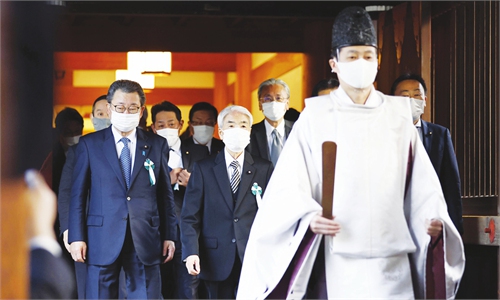
The battleship USS Arizona burns and sinks after the Japanese attack on Pearl Harbor, Honolulu, Oahu, Hawaii, December 7, 1941. Photo: CFP
December 7, 2021, marked the 80th anniversary of the Japanese sneak attack on the US naval base at Pearl Harbor, an act which brought the US into World War II as a combatant nation. It is a day, according to then-US president Franklin Roosevelt, "that will live in infamy." Today a memorial stands over the wreckage of the USS Arizona, sunk during the Japanese attack, marking the final resting place of 900 of the ship's 1,177 crewmen who lost their lives. Nearby, at anchor, is the USS Missouri, the battleship upon which the documents of surrender were signed on September 2, 1945, ending the war Japan had started.One would think that a nation which had fought and lost a war of is own making, losing 2.1 million military personnel and another 500,000-800,000 civilians dead and leaving its cities in ruin would spend the day that marks its precipitous and suicidal entry into war with the US in quiet reflection on the high cost of militarism. Instead, nearly 100 Japanese lawmakers from several political parties decided to mark the day by visiting the Yasukuni Shrine, established in 1869 to commemorate and honor the achievements of those who gave their lives in service to the Emperor.
While the Yasukuni Shrine celebrates the sacrifice made by Japanese soldiers and civilians prior to WWII, it also enshrines those who died in that conflict, including hundreds of war criminals. The celebration of their enshrinement by modern-day Japanese politicians has been condemned by both the Chinese and South Korean governments. The citizens of both these nations were imprisoned, tortured, raped and murdered by the millions at the hands of Imperial Japanese soldiers who were operating under a hybrid ideology which combined the military rites of bushido, the traditional "way of the warrior" practiced by the Samurai class in feudal times, with kodo, or "the way of the Emperor," creating a hyper-nationalistic movement based upon the notion of racial superiority that paved the way for unspeakable cruelty and crimes against humanity perpetrated by the soldiers of Imperial Japan.
What is interesting about the visit to the Yasukuni shrine isn't the fact that China and South Korea have objected, but rather the deafening silence from the US, Australia, and the UK. All three of these nations witnessed firsthand the culture of cruelty which defined Japanese militarism, with their civilian and military prisoners of war systematically murdered at the hands of Japanese soldiers who viewed the act of surrender as being worse than death.
Recently, these three nations have come together to form a new pact, known as AUKUS (Australia, United Kingdom, United States) whose sole purpose is to collaborate on the military containment of China.
The AUKUS pact works hand in glove with another military cooperation organization known as Quad (officially referred to as the Quadrilateral Security Dialogue), comprising the US, Australia, India, and Japan. Like AUKUS, Quad is singularly focused on challenging China militarily in the Indo-Pacific region. The inclusion of Japan in a military alliance seems to run counter to Article 9 of the Japanese Constitution, which states that "the Japanese people forever renounce war as a sovereign right of the nation and the threat or use of force as a means of settling international disputes," and notes that "in order to accomplish the aim of the preceding paragraph, land, sea and air forces, as well as other war potential, will never be maintained. The right of belligerency of the state will not be recognized."
Despite this constraint, Japanese Prime Minister Fumio Kishida announced that Japan will consider authorizing its so-called "Self-Defense Force" to incorporate offensive strike capabilities to better respond to perceived threats from North Korea and China. Successive Japanese governments have been pressured by the US to "reinterpret" Article 9 in a manner that allows Japan to build a military force capable of meaningfully contributing to American security interests in the Pacific.
The revival of a viable military capability at the behest of the US is at the heart of the decision by Japanese lawmakers to visit the Yasukuni Shrine. That this visit took place on the same day Japan's previous experiment in aggressive militarism chose to launch a surprise attack on the US 80 years ago only speaks to the awful irony of the situation. Americans, it seems, have short memories. The people of China and South Korea do not.
The author is a former US Marine Corps intelligence officer. opinion@globaltimes.com.cn

The battleship USS Arizona burns and sinks after the Japanese attack on Pearl Harbor, Honolulu, Oahu, Hawaii, December 7, 1941. Photo: CFP
December 7, 2021, marked the 80th anniversary of the Japanese sneak attack on the US naval base at Pearl Harbor, an act which brought the US into World War II as a combatant nation. It is a day, according to then-US president Franklin Roosevelt, "that will live in infamy." Today a memorial stands over the wreckage of the USS Arizona, sunk during the Japanese attack, marking the final resting place of 900 of the ship's 1,177 crewmen who lost their lives. Nearby, at anchor, is the USS Missouri, the battleship upon which the documents of surrender were signed on September 2, 1945, ending the war Japan had started.One would think that a nation which had fought and lost a war of is own making, losing 2.1 million military personnel and another 500,000-800,000 civilians dead and leaving its cities in ruin would spend the day that marks its precipitous and suicidal entry into war with the US in quiet reflection on the high cost of militarism. Instead, nearly 100 Japanese lawmakers from several political parties decided to mark the day by visiting the Yasukuni Shrine, established in 1869 to commemorate and honor the achievements of those who gave their lives in service to the Emperor.
While the Yasukuni Shrine celebrates the sacrifice made by Japanese soldiers and civilians prior to WWII, it also enshrines those who died in that conflict, including hundreds of war criminals. The celebration of their enshrinement by modern-day Japanese politicians has been condemned by both the Chinese and South Korean governments. The citizens of both these nations were imprisoned, tortured, raped and murdered by the millions at the hands of Imperial Japanese soldiers who were operating under a hybrid ideology which combined the military rites of bushido, the traditional "way of the warrior" practiced by the Samurai class in feudal times, with kodo, or "the way of the Emperor," creating a hyper-nationalistic movement based upon the notion of racial superiority that paved the way for unspeakable cruelty and crimes against humanity perpetrated by the soldiers of Imperial Japan.
What is interesting about the visit to the Yasukuni shrine isn't the fact that China and South Korea have objected, but rather the deafening silence from the US, Australia, and the UK. All three of these nations witnessed firsthand the culture of cruelty which defined Japanese militarism, with their civilian and military prisoners of war systematically murdered at the hands of Japanese soldiers who viewed the act of surrender as being worse than death.
Recently, these three nations have come together to form a new pact, known as AUKUS (Australia, United Kingdom, United States) whose sole purpose is to collaborate on the military containment of China.
The AUKUS pact works hand in glove with another military cooperation organization known as Quad (officially referred to as the Quadrilateral Security Dialogue), comprising the US, Australia, India, and Japan. Like AUKUS, Quad is singularly focused on challenging China militarily in the Indo-Pacific region. The inclusion of Japan in a military alliance seems to run counter to Article 9 of the Japanese Constitution, which states that "the Japanese people forever renounce war as a sovereign right of the nation and the threat or use of force as a means of settling international disputes," and notes that "in order to accomplish the aim of the preceding paragraph, land, sea and air forces, as well as other war potential, will never be maintained. The right of belligerency of the state will not be recognized."
Despite this constraint, Japanese Prime Minister Fumio Kishida announced that Japan will consider authorizing its so-called "Self-Defense Force" to incorporate offensive strike capabilities to better respond to perceived threats from North Korea and China. Successive Japanese governments have been pressured by the US to "reinterpret" Article 9 in a manner that allows Japan to build a military force capable of meaningfully contributing to American security interests in the Pacific.
The revival of a viable military capability at the behest of the US is at the heart of the decision by Japanese lawmakers to visit the Yasukuni Shrine. That this visit took place on the same day Japan's previous experiment in aggressive militarism chose to launch a surprise attack on the US 80 years ago only speaks to the awful irony of the situation. Americans, it seems, have short memories. The people of China and South Korea do not.
The author is a former US Marine Corps intelligence officer. opinion@globaltimes.com.cn

